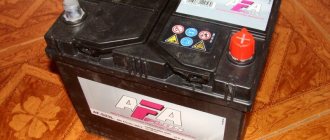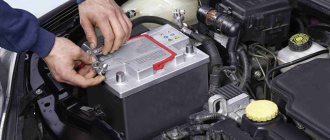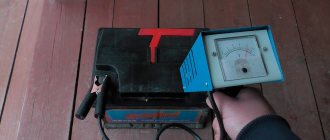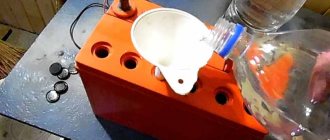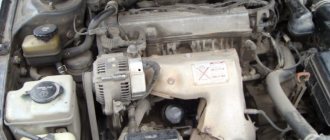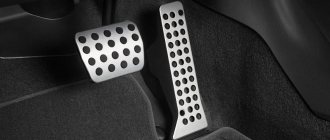Features of maintenance-free batteries
Game - find one difference
(traffic jams)
Maintenance-free batteries are usually called batteries that do not have access to the electrolyte. In other words, they are traffic-free. It follows that when charging a maintenance-free battery it is impossible to:
- Measure the electrolyte level.
- Replenish his losses if necessary.
- Measure the density of the electrolyte.
- Adjust it if necessary.
- See the boiling process.
But the listed manipulations are familiar and very useful when charging conventional, serviced batteries. For example, they yawned with current or voltage, boiled the battery - and did not even see when and how it happened. The electrolyte level has dropped - you cannot top it up. There is nothing to talk about density at all.
Contrary to common misconceptions, which are briefly discussed below, maintenance-free batteries are made this way for convenience and safety. After all, any inept actions with electrolyte are always fraught with danger. Both for the user’s health and for the battery life. Acid can burn your skin, cause poisoning, and damage your eyesight. And if you add electrolyte or even water to the battery without understanding what is happening, you can take away its health.
Maintenance-free batteries are an attempt by manufacturers to free car enthusiasts from inconvenient and dangerous fiddling with electrolyte when charging. But don’t think that everything is simple - you don’t equip the battery with plugs, and you’re done. Keep your battery maintenance free. No. Everything is much more complicated. At a minimum, since the manufacturer does not provide access to the electrolyte, he makes sure that it is more difficult for a maintenance-free battery to boil due to inept charging.
This can be achieved by applying special alloying coatings to lead plates. The most common boil protection is calcium. Due to its presence on the surface of the plates, the electrolysis process when charging the battery begins at a much higher voltage than without such a coating. For example, if previously ordinary batteries easily boiled at 14.5 V, then modern calcium batteries do not boil until you apply 15-16 V to them.
Other solutions are being implemented. For example, a well-thought-out system for relieving excess pressure and balancing it between all compartments. Some manufacturers achieve good results by introducing their proprietary systems for stirring the electrolyte to prevent stratification. And so on.
Maintenance-free batteries are...
View other surveys from Auto without a service station
From the above it should be clear that car AGM and GEL batteries should also be considered maintenance-free. To learn how to charge them correctly, follow the links hidden in the names of the technologies. Looking ahead, we note that both AGM and GEL batteries have their own nuances regarding charging. And they differ from batteries with bulk electrolyte. That is, the algorithm provided below for gel and AGM batteries is not suitable.
How to charge a maintenance-free battery
Charging a maintenance-free battery is done in two ways:
- Direct current.
In this case, the initial current does not change, you need to change the voltage supply. For example, direct current is 2A, voltage at the beginning is 15V, and at the end of the charge is 14.3V.
- Constant tension.
In this method, the initial voltage does not change; it is enough to change the current indicators. For example, at the beginning of the process it is necessary to set the voltage to 14.4V and the current to 10A. By the end, the current may drop to 0.2A.
Charging instructions are as follows:
- Place the battery on a flat surface or leave it inside the car.
- Connect the crocodiles from the charger to the battery according to the polarity.
- Estimate the output voltage of the batteries. If the parameter is less than 11 volts, then the battery has suffered a deep discharge and it will not be possible to fully restore its capacity.
- Approximately estimate the battery charge time using the output voltage.
- Apply voltage 12.6V, observe the device for 30 minutes. If the battery has not warmed up, increase it to 14.4V.
- Monitor the decrease in parameters on the ammeter. When the lower limits of 0.5-1A are reached, stop charging.
It is recommended to charge inside a warm room. If you recharge a maintenance-free battery in the garage, you do not need to remove the battery. The main thing is to turn off possible sources of power consumption in order to properly charge the battery.
Charger
Correctly charging maintenance-free car batteries requires knowing the answers to the following questions:
- Which charger is suitable?
- What type of charge causes maintenance-free batteries to die most often?
- When should you charge?
- What voltage?
- What current?
- How long?
- Do I need to boil a maintenance-free battery when charging to avoid stratification?
Here are the answers to all these questions.
Which charger should I use to charge?
It’s not worth overpaying for “smart” memory devices, especially
if you have read several materials about batteries on the Auto without a service station website
The correct choice of charger for charging a car battery is described in as much detail as possible in a separate material. You can find it using the link above. If
The process of charging a maintenance-free battery
Like any other battery, it is recommended to remove it from the car before charging, so that in case of unforeseen circumstances, access to it is provided from all sides, and the insides of the car are not damaged by the contents of the battery. To ensure maximum safety, the battery is charged only on a flat and smooth surface to prevent it from accidentally tipping over.
Sometimes they ask how to properly charge the battery without removing it from the car. This is not recommended. But if such a need nevertheless arises, all possible power supplies to the car must certainly be turned off, and the ignition key must be removed from the lock .
Immediately before charging, you need to measure the residual voltage using a voltmeter or multimeter. If the battery is partially or completely discharged, the voltage should be supplied continuously, 14-14.5 V, and the current should initially not be higher than 2 A.
If the battery is not so discharged, its recharging time will, on average, be from 3 to 4 hours. If deeply discharged, it may take several days to fully charge. The process must be constantly monitored. When the current reading drops to 0.2 A, it means the battery is fully charged. Many maintenance-free batteries are equipped with an indicator that lights up green when the charging time is complete.
Since the electrolyte of any composition also undergoes chemical reactions during the charging process, it is important to monitor the battery and listen to what is happening inside it to prevent the electrolyte from boiling. In a serviced battery, it is easier to monitor the condition of the electrolyte due to the fact that you can carefully open the compartment of a particular can and check what is happening in it. In the case of a hermetically sealed case, this is more difficult to do, but it is possible, provided you are vigilant and attentive. When the electrolyte boils, the charger must be quickly disconnected.
In order not to accidentally drain a car battery with a charger, the current current should not exceed 15 A, and the voltage in the battery should not exceed 15.5 V. These are extreme voltage readings.
Let's summarize
As a result, we get the following brief instructions for charging a maintenance-free car battery:
- Determine whether you need to charge.
- Check the excess pressure relief valves (they should not be clogged with dirt).
- Limit the charging current to the charger in accordance with the actual battery capacity (10% taking into account the service life).
- When the voltage at the terminals reaches 14.4 V, make sure that it does not rise higher.
- Charge until the charging current is stable at 14.4V for two hours.
If, however, you decide to boil the battery in order to mix the electrolyte to avoid stratification, do it this way. At the very end of the charge (see point 5 above), raise the voltage to 15-16 V, and charge in this mode for no more than 30-40 minutes. At the same time, do not move away from the battery - if the case heats up above 40°C, a whistling or hissing sound appears - immediately disconnect the charger and complete charging.
It should also be clear that maintenance-free batteries such as GEL and AGM are not afraid of stratification. Accordingly, you should not try to boil them.
How to charge
Now directly about how to properly charge your maintenance-free battery and what you need to know to do this.
The procedure can be performed in 2 ways.
- D.C. Here the initial current parameters will not change. But you will need to change the voltage supply. For example, the direct current will be 2 A, and the voltage will initially be 14.8, and by the end of the procedure it will drop to 14.3 V.
- Constant pressure. Here the initial voltage will not change, but the current value is adjusted. For example, the voltage is initially set to 14.4 V, otherwise it will be 10 A. By the end of the charge, the current drops to 0.2 A.
In the case of maintenance-free batteries, due to the hermetically sealed housing, it is under no circumstances possible to set the charging voltage above 15 V.
Self-charging a maintenance-free battery from a car, carried out at home, should not cause any special problems when using modern chargers.
You can give approximate instructions on how to properly charge maintenance-free car batteries:
- The battery is placed on a flat surface. But you can also leave it in the engine compartment, observing safety precautions.
- Next, connect the crocodiles from the charger, observing the polarity.
- Take measurements of the current voltage from the battery. If the charge drops to 11 V, there is no point in charging. This indicates a deep discharge, after which the device cannot be restored.
- Calculate the charging time based on the output voltage data.
- Apply a voltage of 12.6 V. Observe the battery for the first 30 minutes. If the electrolyte has not begun to boil, the voltage can be raised to 14.4 V.
- At the same time, watch how the readings on the ammeter drop. As soon as they reach the lower limit of 0.5-1 A, the charger can be turned off.
This will allow you to understand how to properly charge your maintenance-free battery if you use a regular inexpensive battery charger. Modern charging has been improved, and all you need to do is connect the terminals, plug it in and start the process. The automation itself will turn off the charge when it reaches the required values.
Based on the instructions presented, you can recharge your maintenance-free battery yourself. If the procedure is performed without removing it from the vehicle, make sure that all energy consumers are turned off.
The optimal solution would be to use automatic storage. With its help, charging a dead, maintenance-free battery at home is a pleasure.
In the first hour of operation, such batteries provide maximum current, in the second hour they reduce it by 2-3 times, and after 5 hours the process proceeds at minimum values.
The use of automatic chargers allows you to make the correct charge and prevent the electrolyte from boiling.
So, whenever possible, use these charging stations.
Charging a maintenance-free battery at home
It is dangerous to charge serviced batteries at home: when the battery heats up during charging, gases that are harmful to health are released, which are also explosive. Unlike lead-acid batteries, charging a maintenance-free car battery at home is quite possible due to the sealed nature of its case. Of course, it is desirable that the room is well ventilated, and that the battery itself is located as far as possible from open sources of fire.
Charging is carried out by a device on which voltage readings are set from 14 to 14.5 V, in direct current mode: it, as always, is the most humane and safe for both any battery and the entire surrounding space. At the end of charging, the voltage can be reduced to 13.2 V
Thus, it becomes clear how to charge a maintenance-free battery and what rules must be followed, taking into account the features of modern battery designs. Such batteries are indeed very easy to use and safer than lead-acid batteries, although they sometimes require a longer charging process. However, caring for them is not particularly difficult, and if you learn how to charge them yourself, you can enjoy not only the ride, but also the awareness of your own skill.
